This is the fourth annual tracking report produced through a collaboration between Him For Her and Crunchbase. Contributors include Laura Gluhanich, Riya Hariharan and Sierra Scanlan of Him For Her, Cynthia Overton of Kapor Center, and Gené Teare of Crunchbase. Lauren Rivera, professor at Kellogg School of Management, co-authored the original 2019 benchmark study, upon which subsequent research has been based.
Executive summary
As investors and other stakeholders put increasing pressure on public companies to build boards that better reflect society, the root cause that inhibits board diversity has become clearer. It’s not a pipeline problem. It’s a network problem. Boards have been over-reliant on their personal networks to source candidates.
For high-growth private companies — the subject of our research — this problem is compounded by two structural issues.
First, the lack of diversity among investors and the entrepreneurs they back shapes the demographics of the boardroom. Our study found that men hold 88% of investor-director board seats and 91% of executive board seats.
Search less. Close more.
Grow your revenue with all-in-one prospecting solutions powered by the leader in private-company data.
Second, independent director seats — which provide companies with the opportunity to round out the board with directors who bring relevant operating experience and new perspectives — remain unfilled. Even though the organizational documents for venture-backed companies typically specify a number of independent board seats, nearly a fifth of the heavily funded, high-growth companies we studied don’t have a single independent director. Another quarter of the companies have only one.
Encouragingly, the number of companies with independent directors is on the rise. Additionally, companies are adding independent directors at an earlier stage. Among the venture-backed companies to which Him For Her has introduced their newest board members, 69% of those were Series C or earlier. The expertise and fresh perspective these independent directors can provide should better position the companies to capitalize on the opportunities before them.
Why this study?
You can’t change what you can’t measure. Early in our work to accelerate gender diversity on corporate boards, we at Him For Her sought out benchmarks against which to measure progress. We found several studies tracking board diversity among public companies, but little data on the demographic composition of the boards of high-growth private companies.
Board diversity is important for public companies, but it’s equally important for the boards of these private companies. In fact, nearly half of public companies founded since 1979 began as venture-backed startups. Before they hit the public markets, private companies create the products and services, and define the business models that will shape society for decades to come. They surpass public companies in number and employ millions of people. And yet these future public companies have been largely overlooked when it comes to the composition of their boards.
In 2019, Him For Her teamed up with Crunchbase to benchmark private-company boards. Through our annual research and reporting, we examine board diversity among the most heavily funded private companies and explore the unique dynamics that shape their boardrooms.
This fourth annual study encompasses the boards of 667 companies, which represent nearly $200 billion in funding and employ more than 265,000 people. These boards include 4,035 individuals who hold 4,610 board seats.
Key findings
- Between 2019 and 2022, women gained an average of just over half a board seat (0.6); women now represent roughly 1 out of 7 board members.
- Women hold 16% of board seats among the companies studied, up from 14% in 2021 and 7% in our original study in 2019.
- Nearly a third (32%) of companies don’t have any women on their boards, an improvement from 39% in the prior year. The companies with all-male boards represent $56 billion in funding and employ more than 78,000 people.
- Only 4% of all directors are women of color,1 reflecting a slight improvement from 3% in the prior year. For the first time, the number of women of color surpassed the number of board members named “Dave.”
- More than three quarters of company boards (76%) do not include a single woman of color.
- Women are most likely to occupy an independent director seat (54%), as compared with an investor director (34%) or executive director (13%) seat.
- Investor directors hold fewer than half of board seats (47%, down from 56% in 2019), as independent directors command a larger board footprint (31%, up from 20% in 2019).
- Companies with at least one woman on the board have raised an average of 16% more in cumulative funding than companies without any women board members.
- Life sciences companies outperform technology companies on board-diversity metrics.
When we began our study in 2019, 60% of the company boards we examined were all men. Four years later, that has dropped to 32%. Despite this notable improvement, women still hold an average of only one seat on every seven-member board, and the pace of change is slowing. When life sciences companies, which tend to perform better on board-diversity measurements, are excluded, the diversity picture for technology companies looks even worse.
Women hold an average of one seat per seven-person board
For the first time since we launched our study in 2019, women averaged one full board seat per company. Men hold an average of six seats per board.
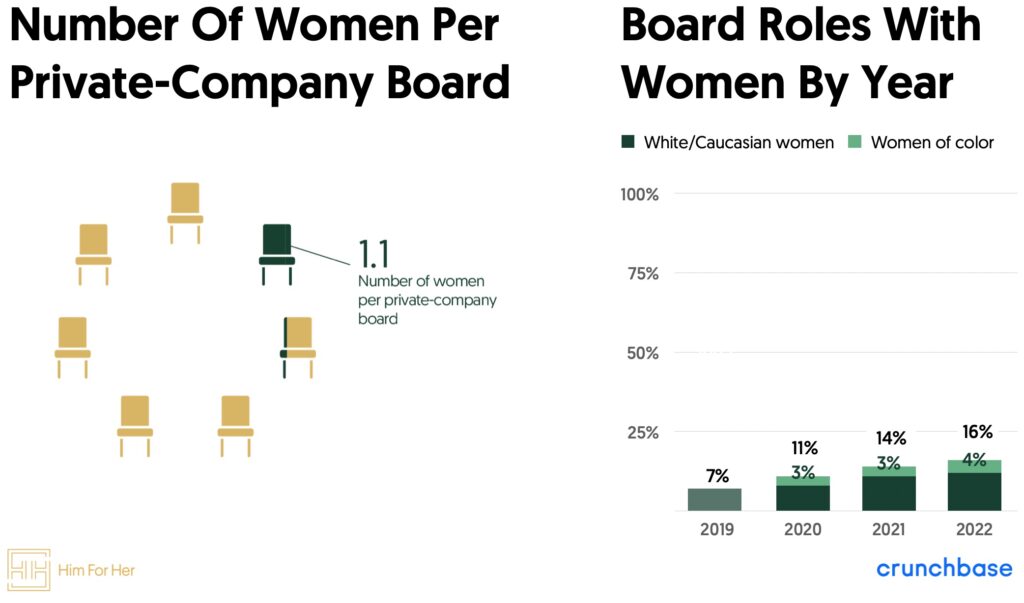
Over the last four years, women have gained just over half a seat (0.6) in the boardrooms of these high-growth companies. They now hold 16% of all board seats, up from 7% in 2019. Among public companies, women hold 32% of the director seats on the boards of S&P 500 companies and 28% on the boards of Russell 3000 companies.
Nearly a third of the companies studied (32%) don’t have any women on their boards. By comparison, among public companies, there are no all-male boards within the S&P 500 and only 2% within the Russell 3000.
In our study, the companies being governed by all-male boards represent more than $56 billion in funding and employ more than 78,000 people.
One-third of women directors are the only women in the boardroom. While research suggests that boards need at least three women to capture the full economic benefits of diversity, only 31% of companies studied have more than one, and just 9% have more than two.
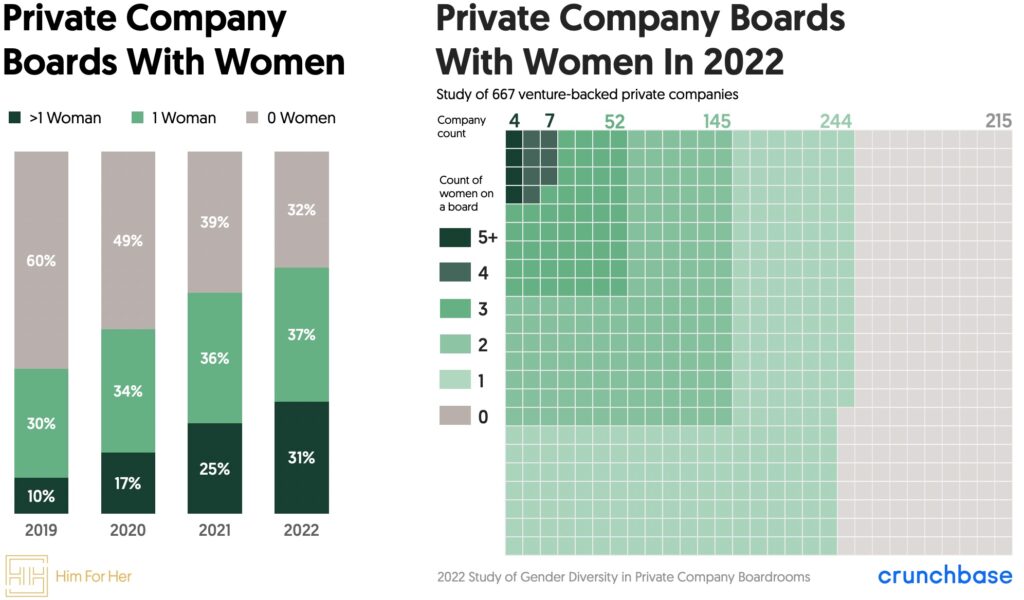
Women of color now outnumber “Daves” in the boardroom
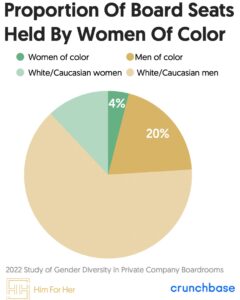 In our last study, we reported that there were roughly as many people named “Dave” or “David” (107) in the boardrooms we examined as there were women of color (110). In 2022, women of color gained nearly one percentage point among board directors, surpassing the number of Daves.
In our last study, we reported that there were roughly as many people named “Dave” or “David” (107) in the boardrooms we examined as there were women of color (110). In 2022, women of color gained nearly one percentage point among board directors, surpassing the number of Daves.
Of the 4,610 board seats included in the study, an estimated 20% are held by men of color and only 4% by women of color, up from 3% the prior year. By comparison, within the S&P 500, 8% of directors are women of color. More than two-thirds (69%) of the private companies studied have at least one man of color on the board, while fewer than a quarter (24%) include a woman of color on their boards. The number of men of color (936) among the board directors studied exceeds the total number of women of all races and ethnicities (668).
Percentage of investor directors continues slow decline
When we began our study in 2019, investors held 56% of all board seats. Over the past four years, that share has decreased to 47%. During this period, the average board size has remained virtually unchanged at 6.9 members.
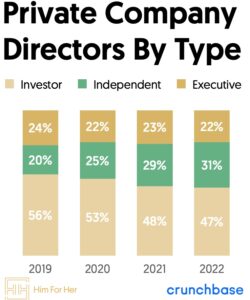 Directors on private-company boards can be classified in three groups: executive directors, investor directors and independent directors. CEOs, co-founders and any members of the company’s management team who hold board seats are considered executive directors. These make up 23% of the board seats within the companies studied, consistent with our findings last year.
Directors on private-company boards can be classified in three groups: executive directors, investor directors and independent directors. CEOs, co-founders and any members of the company’s management team who hold board seats are considered executive directors. These make up 23% of the board seats within the companies studied, consistent with our findings last year.
As venture-backed companies raise outside funding, investors often take seats on the board. Within the study data, investor directors make up the largest pool of board members for venture-backed companies.
Independent directors are typically the last to be added to the board, as they are neither tied to the company’s founding management team nor early investors. Private companies are not required to have independent directors; however, public companies must have at least one independent director, depending on the size of the board.
As the percentage of investor directors has declined, the percentage of independent directors has increased to 31%, up from 20% in 2019. However, 17% of companies don’t have a single independent director on their board (down from 29% in 2019).
Boardroom gains have largely been driven through independent director appointments
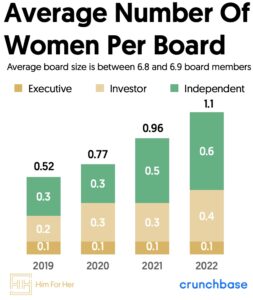 Men hold the majority of board seats, regardless of type. The percentage of women holding executive director and investor director seats has increased modestly over the past four years. However, the greatest gains have been among independent directors, where women now hold 28% of seats, up from 19% in 2019. Since the study’s inception, women have gained an average of 0.6 board seats. More than half of this increase is due to the appointment of women as independent directors.
Men hold the majority of board seats, regardless of type. The percentage of women holding executive director and investor director seats has increased modestly over the past four years. However, the greatest gains have been among independent directors, where women now hold 28% of seats, up from 19% in 2019. Since the study’s inception, women have gained an average of 0.6 board seats. More than half of this increase is due to the appointment of women as independent directors.
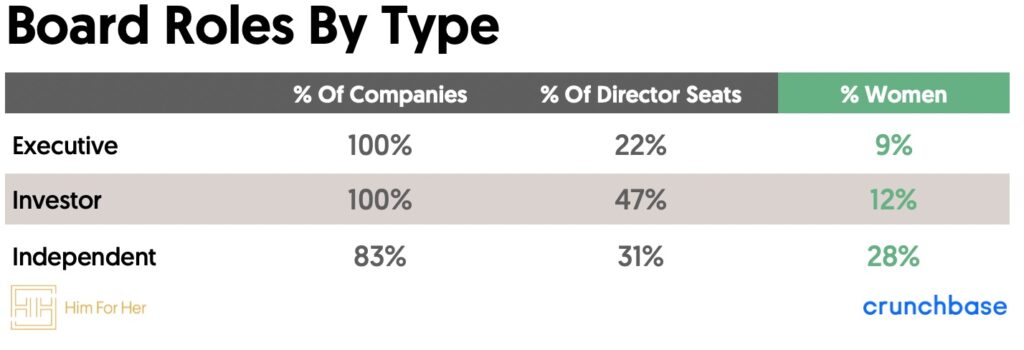
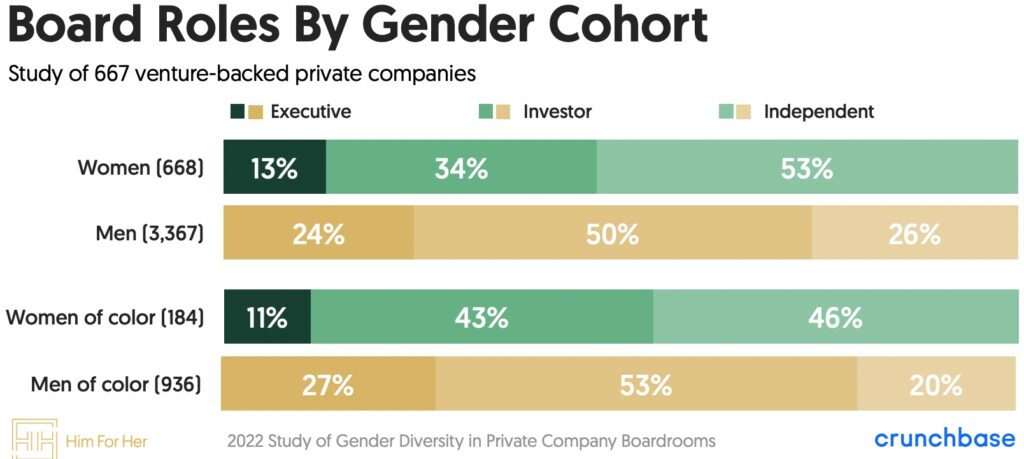
Combined, executive and investor directors hold 70% of board seats, of which only 11% are occupied by women. This gender imbalance reflects the downstream effect of the underrepresentation of women among both startup funders and founders.
Data reveal correlation between funding and women in the boardroom
Companies with at least one woman on the board raised an average of 16% more funding ($302 million) than companies without any women on the board ($261 million). They also have larger boards, with an average of 7.4 directors, compared with companies without women board members (6.0 directors).
This data suggests that, even among companies with a minimal cumulative raise of $100 million, those which have raised more funding have made more progress in building out their boards, appointing one or more independent directors by which they have brought more diversity into the boardroom.
Data also revealed a correlation between women on boards and IPOs. Among the companies examined in our 2021 study, those with at least one woman on the board were 10 times more likely to have gone public the following year than those with all-male boards. Of the 151 companies with at least one woman board member in 2021, 30 (20%) had gone public within the succeeding 12 months. Of the 101 companies with no women on the board, only 2 (2%) had gone public during the same time period.
The board diversity picture dims when life sciences companies are excluded
Among the 667 companies we studied, 46% (306) operate within computer technology-related industries and 40% (269) within the life sciences. Roughly half of the remaining 92 companies are in energy-related industries (45) and the remainder reflect a mix of other fields.
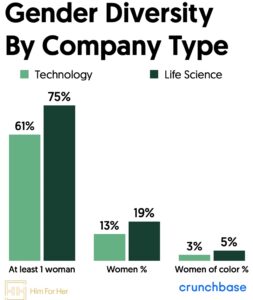 Our research indicates that life sciences companies tend to have more diverse boards than technology companies. Life sciences companies have more women directors (19%, compared with 13%). Three out of four life sciences companies have at least one woman in the boardroom, compared with 61% of tech companies.
Our research indicates that life sciences companies tend to have more diverse boards than technology companies. Life sciences companies have more women directors (19%, compared with 13%). Three out of four life sciences companies have at least one woman in the boardroom, compared with 61% of tech companies.
Women of color hold 5% of the seats on life science boards and 3% on tech boards. Nearly a third (30%) of life sciences companies have at least one woman of color on the board, compared with fewer than a fifth (19%) of tech companies.
These differences cannot be explained by board size. The average number of board members for life science and tech companies is similar (7.0 compared with 6.8, respectively).
Summary
Among public companies, the all-male boardroom is becoming a thing of the past. Yet nearly a third of the private companies we studied remain governed entirely by men. Four years ago, that percentage of all-male boards was nearly twice as high. So clearly the trend toward more inclusive board recruitment that has been reshaping public boards is extending to younger companies. However, women remain dramatically underrepresented in these private company boardrooms, and the rate of change is slowing.
Our research points to two factors that inhibit board diversity among high-growth private companies:
- Lack of gender diversity among investors and the entrepreneurs they fund
- Lack of urgency in appointing independent board members
Additionally, the fact that only 28% of independent directors in place are women reflects an overreliance on existing networks to source candidates.
While gender diversity among investors and the founders they fund continues to slowly improve, independent board seats provide a more immediate way to introduce diversity of experience and perspective to the boardroom. Most CEOs and their boards recognize the value of independent directors, but the competing demands on a startup CEO can relegate this “important-but-not-urgent” opportunity to the back burner.
Him For Her, a social impact venture, was created to remove the friction for CEOs looking to build their boards and extend their networks by connecting them with outstanding candidates who bring expertise and perspectives critical to companies’ success.
The good news is that once boards include a critical mass of women and people of color, the challenge of board diversity will be solved in perpetuity as the board network expands to include people with a wider variety of life experiences.
Methodology
This tracking update largely reproduced the methodology employed with our prior studies published in December 2019, March 2021 and March 2022. For this update, we analyzed 667 of the most heavily funded private U.S.-based companies to understand the composition of their boards as of Q4 2022 — one year after the prior study and three years after the original.
Leveraging the Crunchbase database, we identified 2,626 U.S.-based private companies founded since 2003 with cumulative funding of at least $100 million as of June 30, 2022. To ensure that each company’s board profile was current, we included only companies that publish their board of directors on their website.
We then referenced company website data, Crunchbase profiles and other publicly available information to characterize the board members. The study included only board directors; board observers and/or advisers were excluded from the data set. For each company, we segmented board members according to type: executive, investor or independent. In the few cases in which founders and past executives remained on the board despite no longer having an operating role at the company, we classified them as “executive directors” in recognition of their original relationship to the company. We identified gender by referencing the professional profiles on Crunchbase. For racial/ethnic identity, we leveraged self-identification information where available, and supplemented with contextual information and visual identification. As reflected by U.S. Census data collection, people of color include Black or African American, American Indian or Alaska Native, Asian, Native Hawaiian or Other Pacific Islander, Hispanic or Latino.
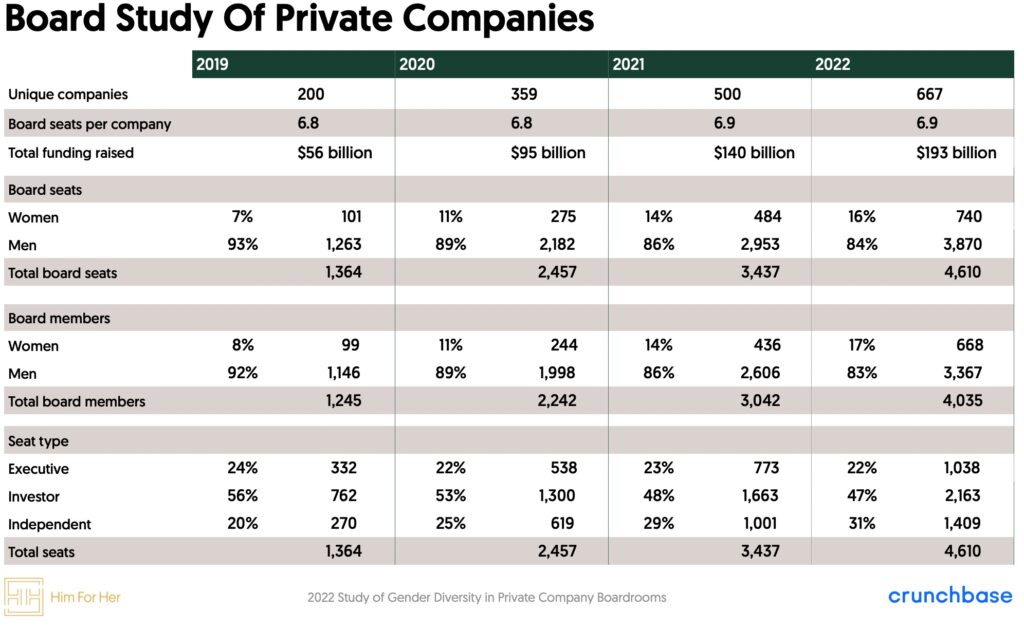
About the Authors
Him For Her is a social impact venture aimed at accelerating diversity on corporate boards. To bridge the network gap responsible for the sparsity of women in the boardroom, Him For Her engages business luminaries and partners with leading private equity and venture capital firms to connect the world’s most talented “Hers” to board service. Drawing from its ever-growing referral-only talent network of 6,000+ women, a third of whom are women of color, Him For Her introduces board-building companies to board-ready candidates. More than 100 board appointments have directly resulted from Him For Her introductions to date. Together with guest hosts like Scott Cook, Carmine Di Sibio, Robin Washington and Eric Yuan, Him For Her also convenes roundtable discussions that extend networks for CEOs and current and aspiring board members. A 501c3 corporation, Him For Her operates through the generosity of its founding partners GV, IVP, L Catterton, Mayfield, Silver Lake Partners, SoftBank, Starboard Value and Tiger Global Impact Ventures, and supporters including Brad Feld & Amy Batchelor, Reid Hoffman, Jeff Weiner, Nasdaq and many others.
Crunchbase is the leading provider of private-company prospecting and research solutions. Over 70 million users — including salespeople, entrepreneurs, investors and market researchers — use Crunchbase to prospect for new business opportunities. Companies all over the world rely on us to power their applications, making over 6 billion calls to our API each year. To learn more, visit about.crunchbase.com and follow us on Twitter @crunchbase.
Illustration: Dom Guzman
Throughout this study, “women of color,” “men of color” and “people of color” refers to individuals likely to identify as Black or African American, American Indian or Alaska Native, Asian, Native Hawaiian or Other Pacific Islander, Hispanic or Latino and/or mixed-race.↩

Stay up to date with recent funding rounds, acquisitions, and more with the Crunchbase Daily.



![Illustration of a guy watering plants with a blocked hose - Global [Dom Guzman]](https://news.crunchbase.com/wp-content/uploads/quarterly-global-3-300x168.jpg)
67.1K Followers